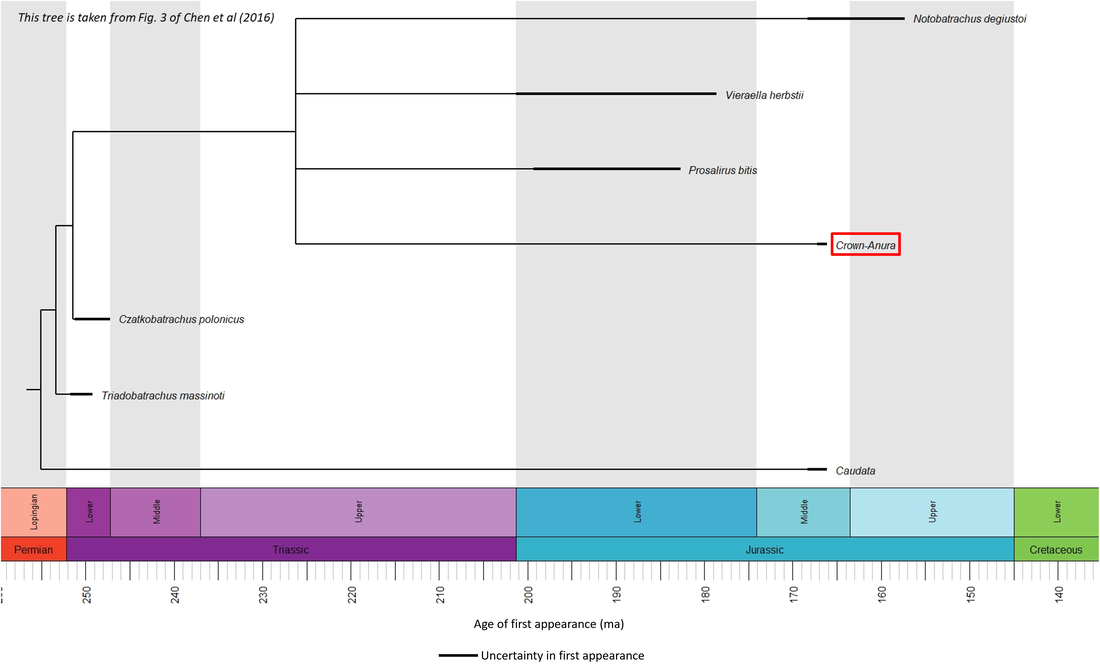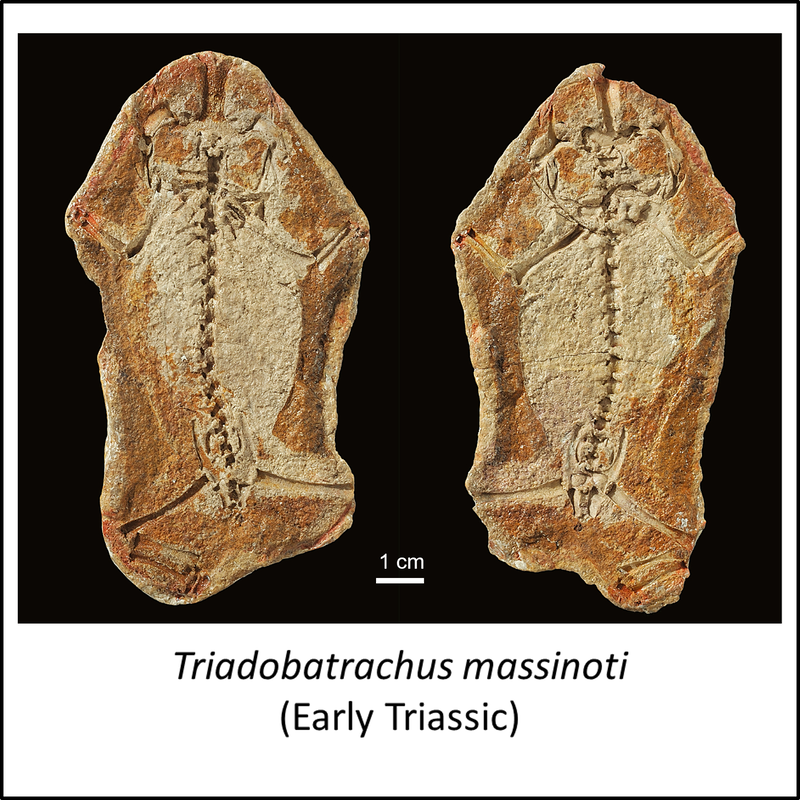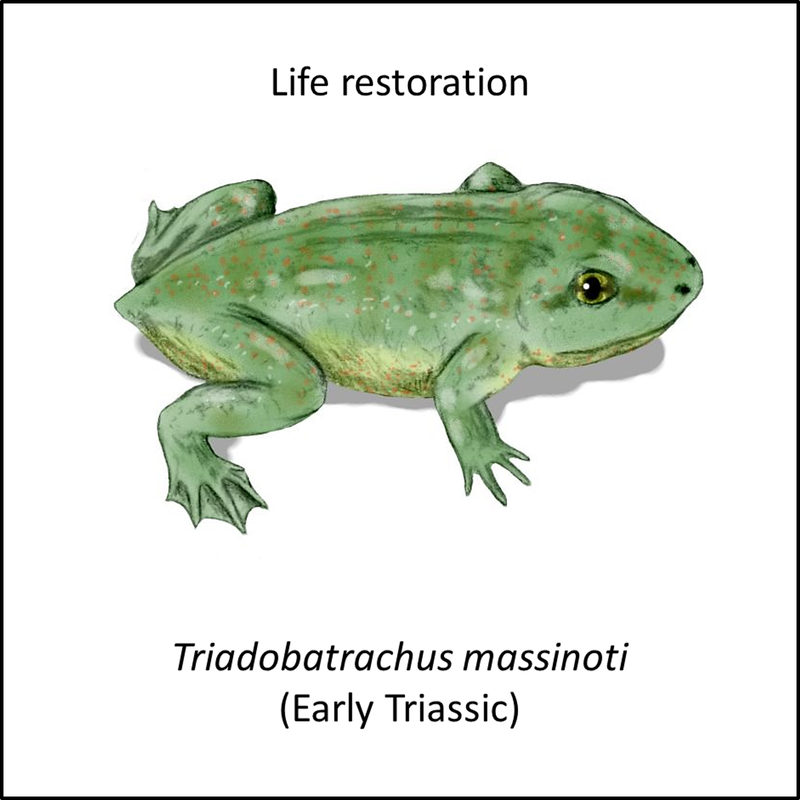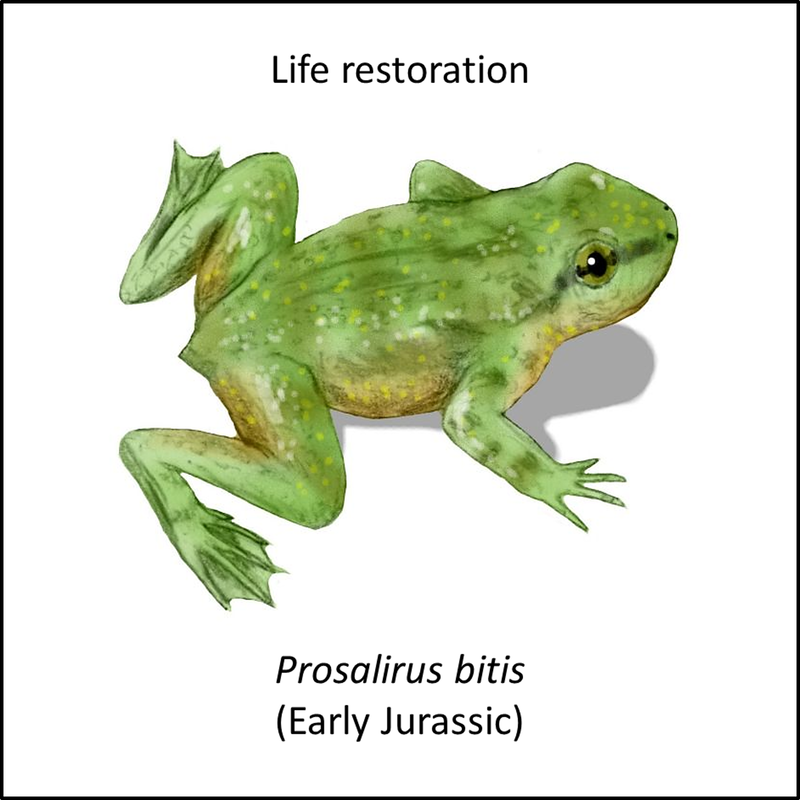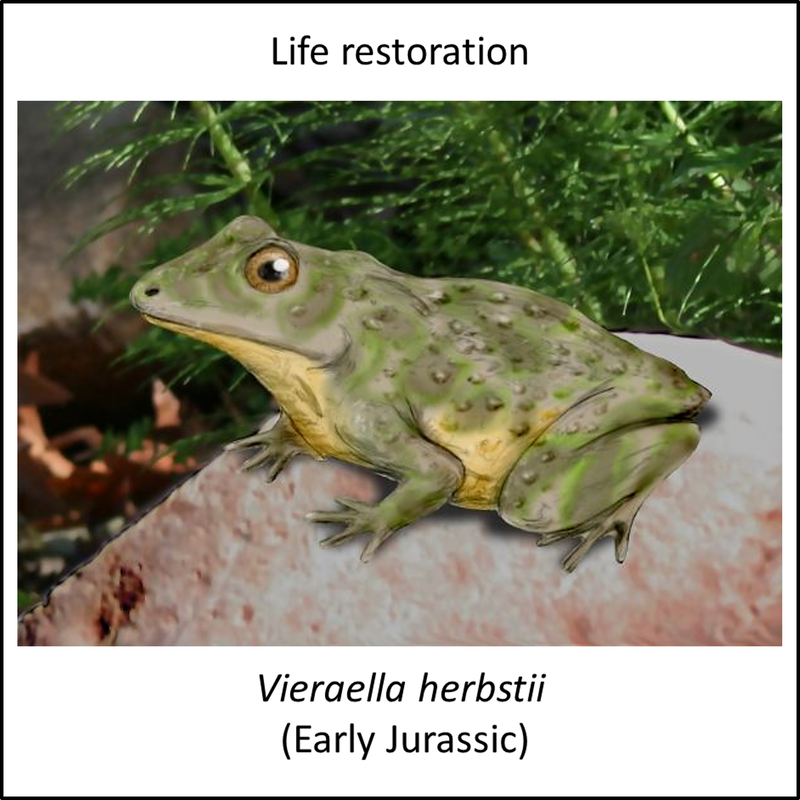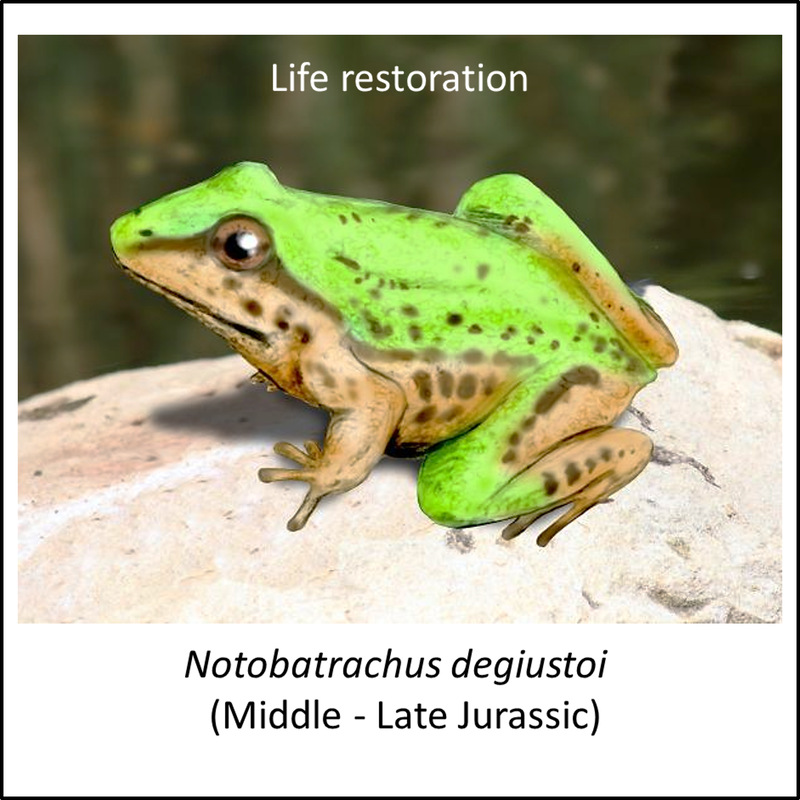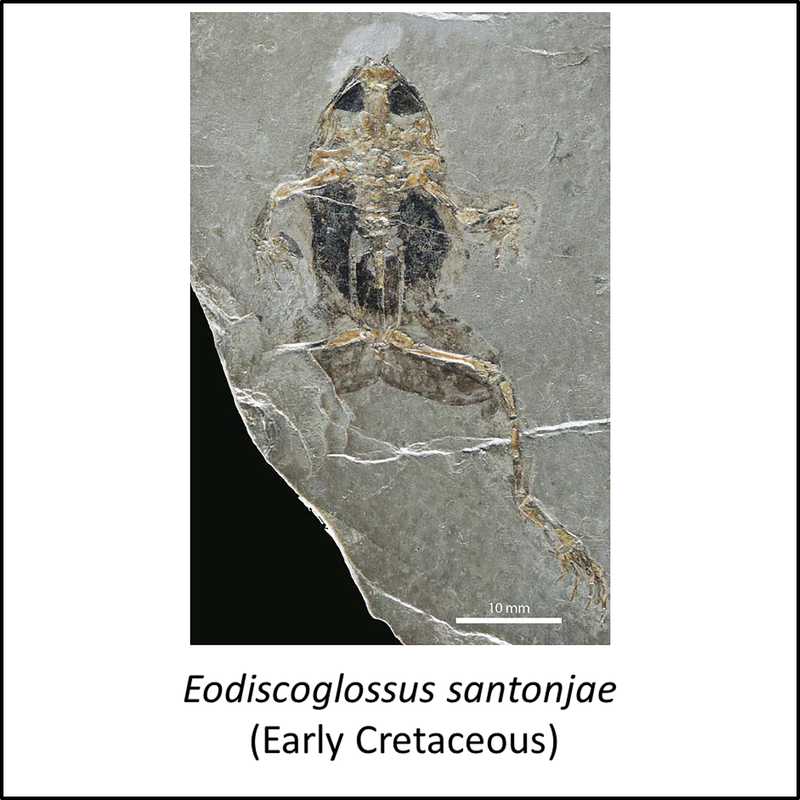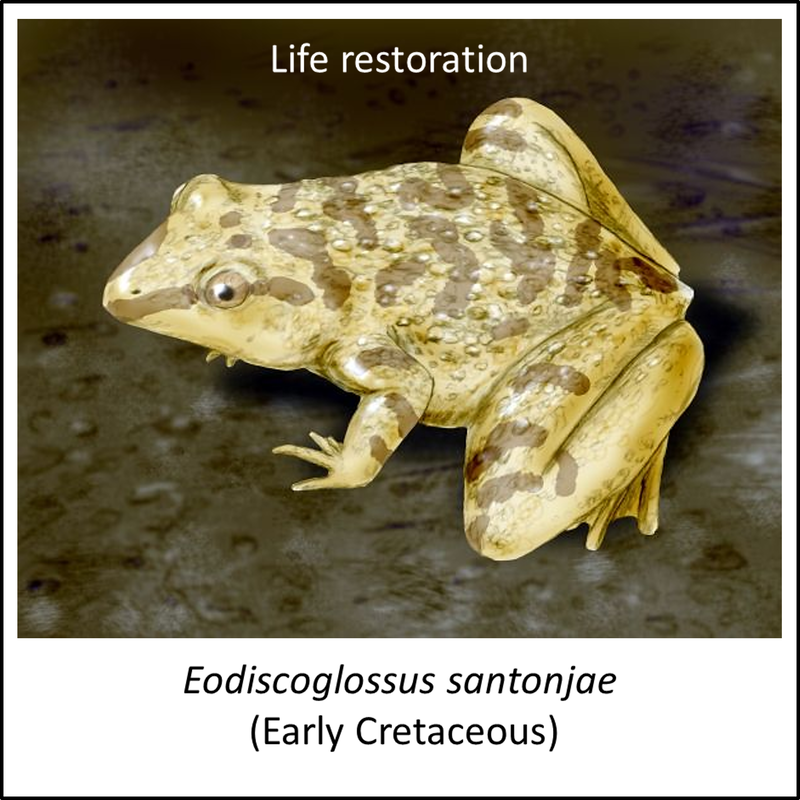The anurans (order Anura, class Amphibia) comprise the frogs and toads. The order comprises more than 7,000 species distributed across more than 50 families.
Only a few stem-group anurans have been recognized, and few phylogenetic studies have been performed in recent years. The analysis by Chen et al (2016), used in the time tree below, appears not to have been superseded.
Only a few stem-group anurans have been recognized, and few phylogenetic studies have been performed in recent years. The analysis by Chen et al (2016), used in the time tree below, appears not to have been superseded.
Figure 1. Phylogenetic time tree of the stem-Anura
There are two possible candidates for the oldest-known fossil of the anuran stem group:
- Triadobatrachus massinoti, found in the Early Triassic (Late Induan - Early Olenekian) Sakamena Group of the Ambilobe district of the Diana Region, northwest Madagascar (Rage and Rocek, 1989; Sigurdsen et al, 2012);
- Czatkobatrachus polonicus, from an Early Triassic (Olenekian) fissure-fill in Carboniferous limestone in the Czatkowice 1 quarry, Malopolskie, Poland (Borsuk-Bialynicka and Evans, 2002).
Figure 2. Images of stem-group anurans
The above images are placed in order of their progression from most basal to those closest to the crown group. They all look very similar, apart from a possible trend of increasing protuberance of the eyes.
The earliest-known fossil representative of the crown group anurans is Eodiscoglossus oxoniensis, a member of the Alytidae family found in the Middle Jurassic (Middle-Late Bathonian) Forest Marble Formation at Old Cement Works Quarry, near Kirtlington, Oxfordshire, England (Evans et al, 1990; Benton et al, 2015). No images of this fossil are available in the public domain, but a reconstruction of another, younger, Eodiscoglossus species is shown below:
The earliest-known fossil representative of the crown group anurans is Eodiscoglossus oxoniensis, a member of the Alytidae family found in the Middle Jurassic (Middle-Late Bathonian) Forest Marble Formation at Old Cement Works Quarry, near Kirtlington, Oxfordshire, England (Evans et al, 1990; Benton et al, 2015). No images of this fossil are available in the public domain, but a reconstruction of another, younger, Eodiscoglossus species is shown below:
Figure 3. Images of crown-group frog Eodiscoglossus santonjae
The above time tree (Figure 1) indicates that the anuran stem group developed from Early Triassic to Middle Jurassic time, representing a stem-to-crown transition of at least 82 million years.
References
Benton, M. J., Donoghue, P. C., Asher, R. J., Friedman, M., Near, T. J., & Vinther, J. (2015). Constraints on the timescale of animal evolutionary history. Palaeontologia Electronica, 18(1), 1-106.
Borsuk-Bialynicka, M., & Evans, S. E. (2002). The scapulocoracoid of an Early Triassic stem-frog from Poland. Acta Palaeontologica Polonica, 47(1).
Chen, J., Bever, G. S., Yi, H. Y., & Norell, M. A. (2016). A burrowing frog from the late Paleocene of Mongolia uncovers a deep history of spadefoot toads (Pelobatoidea) in East Asia. Nature Scientific Reports, 6(1), 1-7.
Evans, S. E., Milner, A. R., & Mussett, F. (1990). A discoglossid frog from the Middle Jurassic of England. Palaeontology, 33(2), 299-311.
Merck, J. (2021). Tetrapoda. Course notes for GEOL 431 Vertebrate Paleobiology, Spring Semester 2021, University of Maryland.
Rage, J. C., & Rocek, Z. (1989). Redescription of Triadobatrachus massinoti (Piveteau, 1936) an anuran amphibian from the early Triassic. Palaeontographica A, 206(1-3), 1-16.
Sigurdsen, T., Green, D. M., & Bishop, P. J. (2012). Did Triadobatrachus jump? Morphology and evolution of the anuran forelimb in relation to locomotion in early salientians. Fieldiana Life and Earth Sciences, 77-89.
Borsuk-Bialynicka, M., & Evans, S. E. (2002). The scapulocoracoid of an Early Triassic stem-frog from Poland. Acta Palaeontologica Polonica, 47(1).
Chen, J., Bever, G. S., Yi, H. Y., & Norell, M. A. (2016). A burrowing frog from the late Paleocene of Mongolia uncovers a deep history of spadefoot toads (Pelobatoidea) in East Asia. Nature Scientific Reports, 6(1), 1-7.
Evans, S. E., Milner, A. R., & Mussett, F. (1990). A discoglossid frog from the Middle Jurassic of England. Palaeontology, 33(2), 299-311.
Merck, J. (2021). Tetrapoda. Course notes for GEOL 431 Vertebrate Paleobiology, Spring Semester 2021, University of Maryland.
Rage, J. C., & Rocek, Z. (1989). Redescription of Triadobatrachus massinoti (Piveteau, 1936) an anuran amphibian from the early Triassic. Palaeontographica A, 206(1-3), 1-16.
Sigurdsen, T., Green, D. M., & Bishop, P. J. (2012). Did Triadobatrachus jump? Morphology and evolution of the anuran forelimb in relation to locomotion in early salientians. Fieldiana Life and Earth Sciences, 77-89.
Image credits – Stem-Anura
- Header (Green and Black Dart-poison Frog, Dendrobates auratus): Geoff Gallice from Gainesville, FL, USA, CC BY 2.0 <https://creativecommons.org/licenses/by/2.0>, via Wikimedia Commons
- Figure 2 (Triadobatrachus massinoti, fossil): Eduardo Ascarrunz; Jean-Claude Rage; Pierre Legreneur; Michel Laurin:, CC BY 3.0 <https://creativecommons.org/licenses/by/3.0>, via Wikimedia Commons
- Figure 2 (Triadobatrachus massinoti, life restoration): Nobu Tamura under a Creative Commons 3.0 Unported (CC BY-NC-ND 3.0) license
- Figure 2 (Prosalirus bitis): Nobu Tamura under a Creative Commons 3.0 Unported (CC BY-NC-ND 3.0) license
- Figure 2 (Vieraella herbstii): Nobu Tamura under a Creative Commons 3.0 Unported (CC BY-NC-ND 3.0) license
- Figure 2 (Notobatrachus degiustoi): Nobu Tamura under a Creative Commons 3.0 Unported (CC BY-NC-ND 3.0) license
- Figure 3 (Eodiscoglossus santonjae, fossil): Báez, Ana Maria & Gómez, Raúl O., CC BY 4.0 <https://creativecommons.org/licenses/by/4.0>, via Wikimedia Commons
- Figure 3 (Eodiscoglossus santonjae, life restoration): Nobu Tamura under a Creative Commons 3.0 Unported (CC BY-NC-ND 3.0) license
